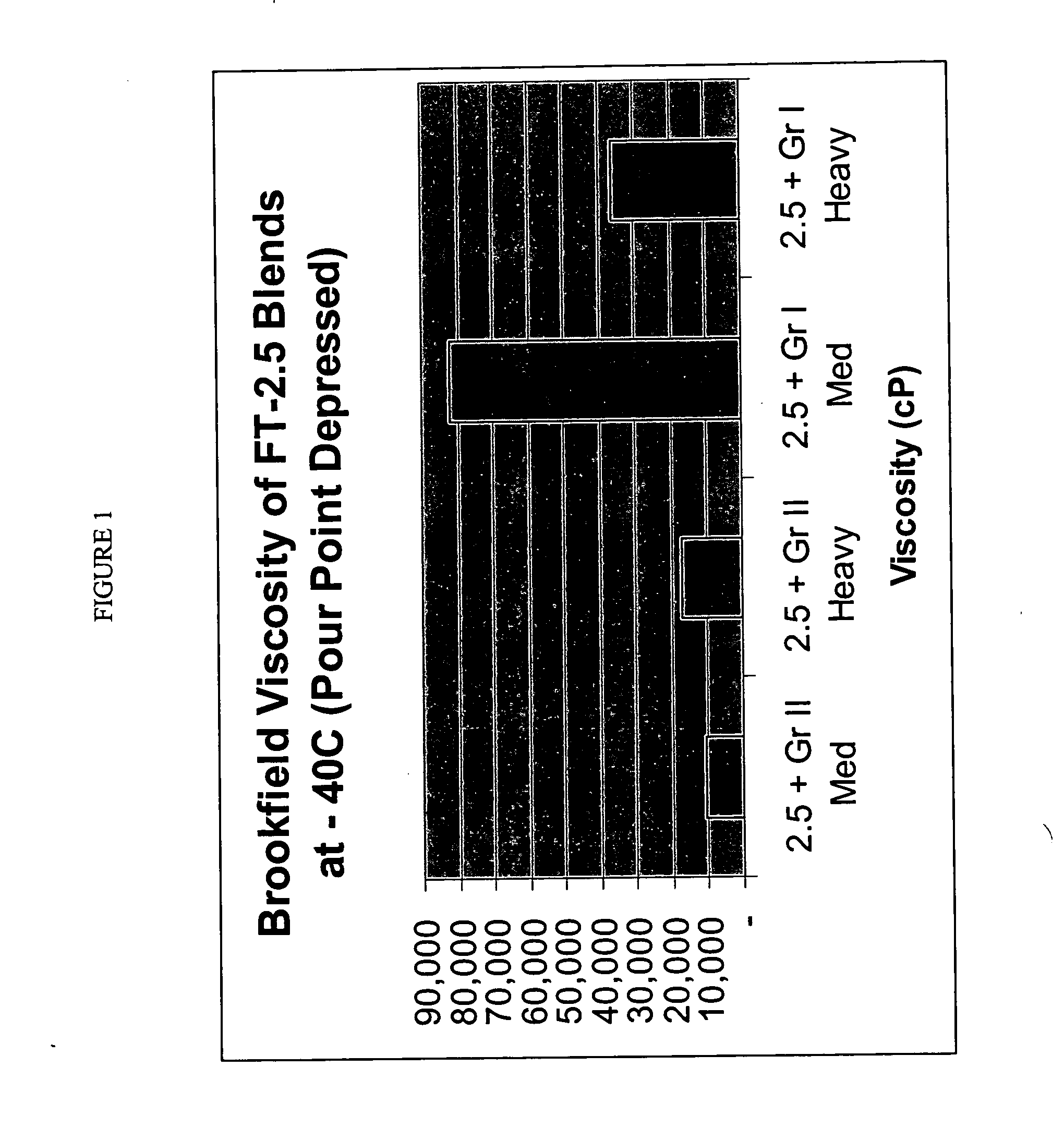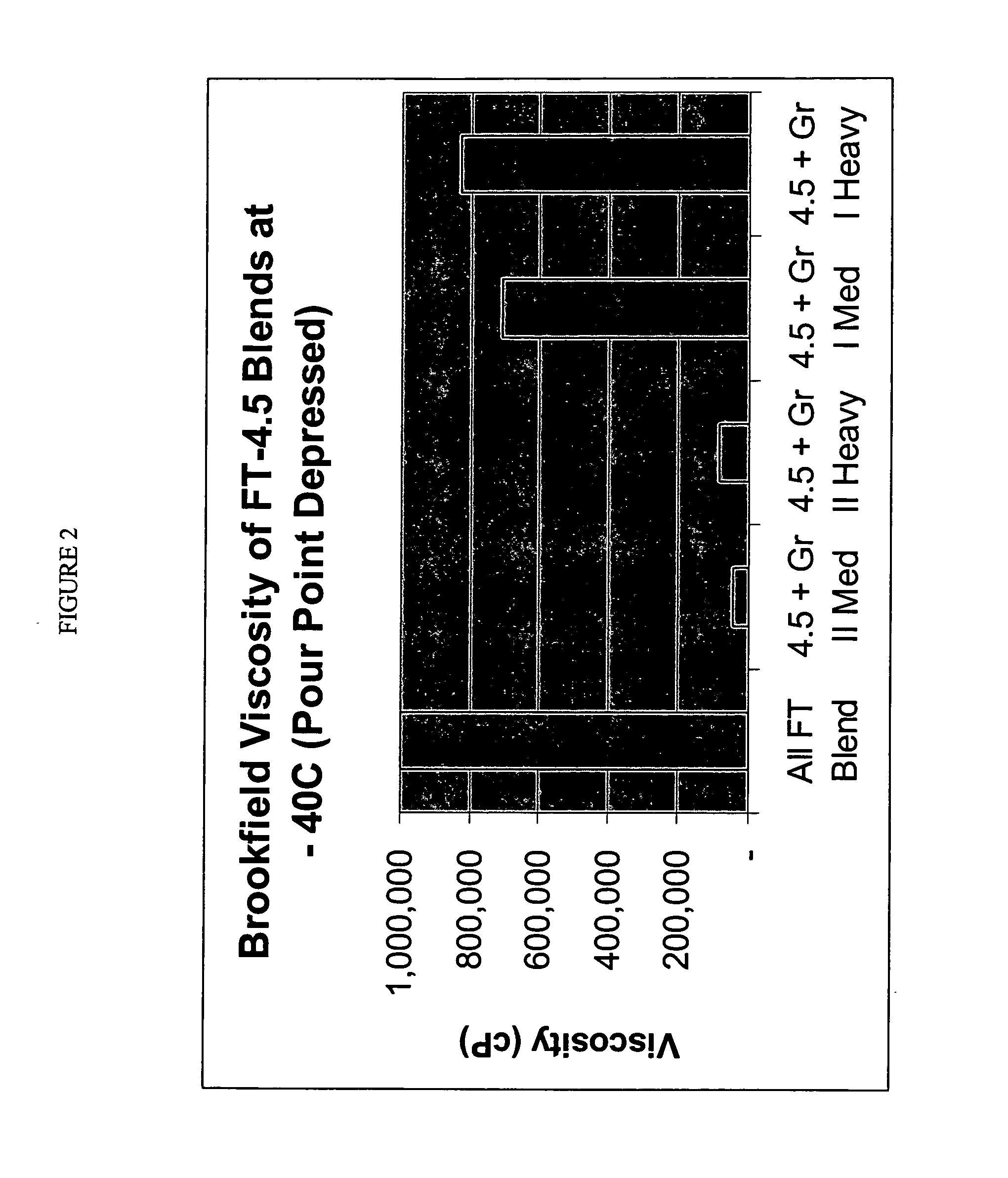Processes for making lubricant blends with low brookfield viscosities
a technology of lubricant blends and brookfield, which is applied in the direction of hydrocarbon purification/separation, nuclear engineering, nuclear elements, etc., can solve the problems of not showing all of the desirable performance characteristics of fischer-tropsch derived lubricants, significantly increasing the cost of lubricant base oil, and not being able to achieve the desired performance characteristics. , to achieve the effect of excellent low temperature properties and low brookfield viscosity
- Summary
- Abstract
- Description
- Claims
- Application Information
AI Technical Summary
Benefits of technology
Problems solved by technology
Method used
Image
Examples
example 1
Fischer-Tropsch Wax and Preparation of Fischer-Tropsch Lubricating Base Oils
[0128] Two samples of hydrotreated Fischer-Tropsch wax, FT Wax A and FT Wax B, were made using a Co-based Fischer-Tropsch catalyst. Both samples were analyzed and found to have the properties shown in Table I.
TABLE IFischer-Tropsch WaxFischer-TropschCatalystCo-BasedCo-BasedFischer-Tropsch WaxFT Wax AFT Wax BSulfur, ppm7, Nitrogen, ppm6, 512, 19Oxygen by Neutron Activation, Wt %0.590.69Oil Content, D 721, Wt %5.986.68GC N-Paraffin AnalysisTotal N Paraffin, Wt %84.4783.72Avg. Carbon Number27.330.7Avg. Molecular Weight384.9432.5D-6352 SIMDIST TBP (WT %), ° F.T0.5515129T5597568T10639625T20689674T30714717T40751756T50774792T60807827T70839873T80870914T90911965T959351005T99.59781090
*duplicate tests
[0129] The Fischer-Tropsch waxes had a weight ratio of compounds having at least 60 carbons atoms to compounds having at least 30 carbon atoms of less than 0.18 and a T90 boiling point between 900° F. and 1000° F. Thre...
example 2
Preparation of Lubricant Blends
[0132] The Fischer-Tropsch derived lubricant base oil fractions prepared above (FT-2B, FT-were and FT-8B) were used to make lubricant blends with petroleum base oils. The Petroleum Base Oils used to blend with the Fischer-Tropsch derived lubricant base oils fractions are as follows:
TABLE IIIPetroleum Base OilsGroup I MediumGroup I HeavyGroup II MediumGroup II HeavyPropertiesNeutralNeutralNeutralNeutralDescriptionExxonMobilExxonMobilChevronTexacoChevronTexacoAC330AC600220R600RViscosity at7.99812.256.50212.37100° C.Viscosity Index9898103100Pour Point, ° C.−9−8−14−16
[0133] Four different blends of FT-2B with the petroleum derived Group I or Group II base oils summarized in the table above, and polymethacrylate pour point depressant were prepared. All four of these lubricant blends had kinematic viscosities within one of the preferred ranges of about 3 cSt or greater and less than 5.0 cSt.
TABLE IVLubricant Blends with FT-2Bw / Group Iw / Group Iw / Group II...
example 3
Comparative Example
[0137] A sample of hydrotreated Fischer-Tropsch wax, FT Wax C, was made using a Fe-based Fischer-Tropsch catalyst. The sample, FT Wax C, was analyzed and found to have the properties shown in Table VI.
TABLE VIFT Wax CFT Wax CSulfur, ppmNitrogen, ppmOxygen by Neutron0.15Activation, Wt %Oil Content, D 721,Wt %Average Carbon41.6NumberAverage Molecular585.4WeightD 6352 SIMDISTTBP (WT %), ° F.T0.5784T5853T10875T20914T30941T40968T50995T601013T701031T801051T901081T951107T99.51133
[0138] A sample of the FT Wax C was hydroisomerized over a Pt / SAPO-11 catalyst on an alumina binder. Operating conditions included temperatures between 652° F. and 695° F. (315° C. and 399° C.), LHSVs of 1.0 hr−1, reactor pressure of 1000 psig, and once-through hydrogen rates of between 6 and 7 MSCF / bbl. The reactor effluent passed directly to a second reactor containing a Pt / Pd on silica-alumina hydrofinishing catalyst also operated at 1000 psig. Conditions in the second reactor included a te...
PUM
| Property | Measurement | Unit |
|---|---|---|
| Temperature | aaaaa | aaaaa |
| Temperature | aaaaa | aaaaa |
| Temperature | aaaaa | aaaaa |
Abstract
Description
Claims
Application Information
 Login to View More
Login to View More - R&D
- Intellectual Property
- Life Sciences
- Materials
- Tech Scout
- Unparalleled Data Quality
- Higher Quality Content
- 60% Fewer Hallucinations
Browse by: Latest US Patents, China's latest patents, Technical Efficacy Thesaurus, Application Domain, Technology Topic, Popular Technical Reports.
© 2025 PatSnap. All rights reserved.Legal|Privacy policy|Modern Slavery Act Transparency Statement|Sitemap|About US| Contact US: help@patsnap.com


